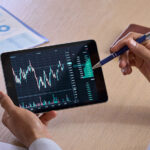watch
A watch is a small timepiece intended to be carried or worn by a person, so as to make the time quickly and conveniently available. It is designed to keep working despite the motions caused by the person’s activities. A wristwatch is designed to be worn on a wrist, attached by a watch strap or other type of bracelet. A pocket watch is to be carried in a pocket. Watches evolved in the 17th century from spring-powered clocks, which appeared as early as the 14th century. The first watches were strictly mechanical, driven by clockwork. As technology progressed, mechanical devices, used to control the speed of the watch, were largely superseded by vibrating quartz crystals, producing accurately timed electronic pulses. Some watches use radio clock technology to regularly correct the time. The first digital electronic watch was developed in 1970. Most inexpensive and medium-priced watches, used mainly for timekeeping, are electronic watches with quartz movements. Expensive collectible watches, valued more for their elaborate craftsmanship, aesthetic appeal and glamorous design than for simple timekeeping, often have purely mechanical movements and are powered by springs, even though these movements are generally less accurate and more expensive than electronic ones. Various extra features, called “complications”, such as moon-phase displays and the different types of tourbillon, are sometimes included. Modern watches often display the day, date, month and year, and electronic watches may have many other functions. Time-related features such as timers, chronographs and alarm functions are common. Some modern designs incorporate calculators, use GPS technology or have heart-rate monitoring capabilities. Watches incorporating GPS receivers use them not only to determine their position. They also receive and use time signals from the satellites, which make them essentially perfectly accurate timekeepers, even over long periods of time. The study of timekeeping is known as horology.













